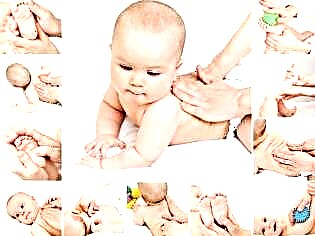
The anxiety of caring mothers who are constantly worried about whether her baby is keeping up with developmental norms is often called by pediatricians "restless mommy" syndrome. Such parents do not crawl out of specialized forums for young mothers and bother the pediatrician with a lot of questions, one of which is: "Is it possible to teach a child to roll over from back to stomach." The well-known pediatrician Yevgeny Komarovsky tells whether it is necessary to do this and how to properly deal with the child.

Standards
The developmental norms that so often make mothers feel flawed are a very vague concept, says Yevgeny Komarovsky. Each child develops according to his own individual program, and comparing him with other children is stupid, and sometimes even criminal. Mothers can never simply compare, but tend to do something so that the child “catches up and surpasses” the neighbor's baby.
The inferiority complex is strengthened by her friends, who, according to them, had children tossing and turning from side to side as early as 2 months, and at 4 the baby began to sit at all. The feeling of catastrophe is generously given by the district pediatricians, who at the next appointment state that if the child does not turn over on his own at 4 months, then this is "bad".


As a result, the mother, driven to despair by worrisome thoughts, is ready to do anything to teach the child at any cost to do what he is not yet able to do at his age.
The problem is not with the child, says Yevgeny Komarovsky, but with parents who attach too much importance to the words of "experts" - neighbors, grandmothers, girlfriends and virtual acquaintances from the Internet. In this situation, it is necessary to treat the mother, not the baby: give her a valerian drink, train her nervous system and endurance.
The norms referred to by "experts" and the local pediatrician exist only in theory. According to them, the average baby begins to roll over at about 4-5 months of age. However, in practice, things are different. Some children make attempts to roll over before this deadline, others do not roll over for 6 months. Such a "lag" is not necessarily caused by illness and some kind of inferiority that anxious mothers instantly think of in their thoughts. There are enough reasons:
- Individual characteristics of temperament (the child is lazy, slow, calm),
- Physique features (the child is well-fed, weighs a little over the norm),
- Combination of the above two factors (very often well-fed toddler is lazy, slow and sleepy).
- The baby was born prematurely.
- A lithe and thin child will begin to roll over earlier than his plump peer. However, this is not at all a reason to sound the alarm and urgently take any active measures.


What should parents do?
First of all, Evgeny Komarovsky advises to calm down and stop comparing the baby with the norms, other children and the experience of friends. If the mother is worried only by the fact that the baby in its 5-6 months does not roll over from the back onto the tummy, and at the same time there are no other complaints (nothing hurts, nothing bothers), then you should leave the child alone and wait until it the muscular system will become so strong that it will turn out easily and naturally. For every baby, this happens in its own time.
If there are additional complaints, then you should definitely visit a pediatrician, orthopedist and neurologist. If the crumbs do not have serious disorders in the activity of the nervous system, everything is in order with the musculoskeletal system, then, again, you should leave the baby alone and give him the opportunity to develop, as nature personally provided for him.


There are not so many diseases that can cause inactivity, and they are all extremely serious. Parents will find out about their presence already in the maternity hospital or at the first scheduled examination of the baby in the clinic. If the doctors didn’t tell you anything before 5 months, and the baby’s card does not include diagnoses like “infantile cerebral palsy”, then you should not “write off” the unwillingness to roll over to the disease.
If parents are completely unbearable to watch the little one lying on his tummy or back and does not feel the need to spin, then you can start giving him a massage aimed at strengthening the muscles of the abdomen, back, and lateral muscles. You can temper the baby, arrange longer walks in the fresh air.
What cannot be done?
In their attempts to help the child in physical development, parents should not go too far, says Yevgeny Komarovsky. So, it is not necessary to hang a five-month-old baby in a jumper, but to put an older baby in a walker (read more about this in the article "From how many months a child can be put in a walker and is it worth it"). These devices are very amusing and touching for parents, but their benefits are much less than real harm. Early verticalization threatens the child with serious problems with the spine in the future, sometimes so serious that the case may end up with a disability.

All classes, if you have already decided to actively help your child, should be reasonable, gentle and competent. It is not necessary to teach a child to sit, toss and turn, stand or walk if his muscular apparatus and spine are not ready for this. When they are ready for the baby to take a new position of the body in space, he will definitely do it himself - this is how nature works.
Thus, the task of parents is only to create favorable conditions under which the strengthening of the back, tummy, legs and arms, as well as the spine, will proceed faster.
Massage and gymnastics
Mothers who bring their baby to the doctor's office complaining that the little lazy person does not want to roll over on his stomach at "their 5 months!" ". Increased muscle tone is characteristic of all newborns, and few babies completely get rid of it by six months.
This fact allows the neurologists themselves and the masseurs, whom they strongly recommend, to make ends meet. Komarovsky claims that no one can massage a healthy child with a diagnosis of hypertonicity (and this is a healthy child!). And this is true not only in terms of saving money, but also for reasons of children's perception of the world. The kid needs tactile contact with his mother, her touch, and not a half-hour heart-rending shout in the hands of an unfamiliar woman with a masseur diploma.


Massage to strengthen the muscles of the back, abdomen is very simple:
- Circular and transverse tummy tricks. Lay the baby on his back, use your thumb to describe circles around the navel, gradually increasing their radius. Use two thumbs to make an arched motion from the navel to the ribs and from the navel to the groin.
- Classic tricks on the back. Place the baby on a firm surface on their tummy. Use the three techniques of classic massage - first stroking, then rubbing and pressure with vibration. Do not rub too hard and press too hard. The child shouldn't be in pain. Ideally, mom should close her eyes and press her finger on her eyelid. As soon as it hurts, this is where there is a limit to the degree of pressure that a small child can withstand.


Massage should be done with warm hands, using baby cream or massage oil. The total duration of the session is no more than 10-15 minutes. If the baby begins to worry and cry, the manipulation should be stopped.
Gymnastics for a toddler may include exercises such as bringing the legs to the stomach while lying on the stomach. If you bring the left leg down, then you can gently turn the child onto the right side. If you bring the right leg, then the turn is to the left. It is important to alternate so that the lateral muscles on both the right and left develop equally well. If the child has already mastered coups, but only in one direction, then you can do exercises with him to train the muscles of the opposite side.
To roll over, the baby must want to do it. An excellent motivation is a bright toy that you need to put in front of him a little to the right or to the left, so that he cannot reach, just lying on his stomach. He will have to stretch to the side, which will be an excellent workout of the lateral muscles.


Komarovsky's advice
As soon as you notice that the child is making independent attempts to roll over, he should no longer be left unattended where he could fall during the roll over. He should not be alone in the room on the couch, on the parent's bed. The changing table is especially dangerous - it can fall from it higher than in the bed. It is safe to leave the baby on the floor, spreading a blanket or sheet on it, in the crib, in the arena.
If a child has learned to roll over in a dream and wakes up from this, try to limit his movements at night - put a blanket or a blanket on both sides, and coups in sleep and in reality will temporarily become impossible, sleep will improve.
Corrective gymnastics for babies will help the baby learn to roll from back to stomach.



